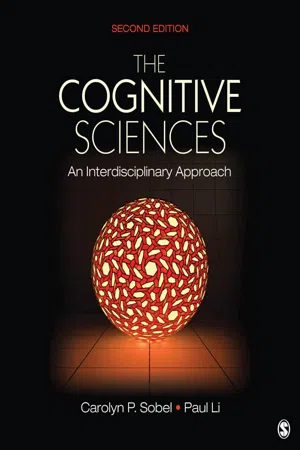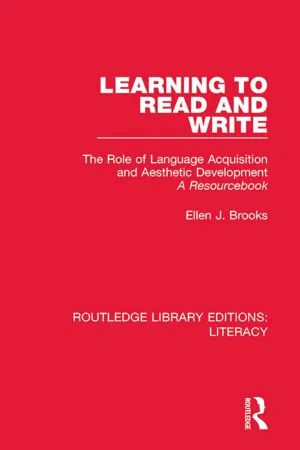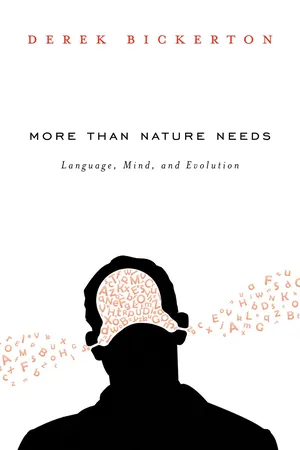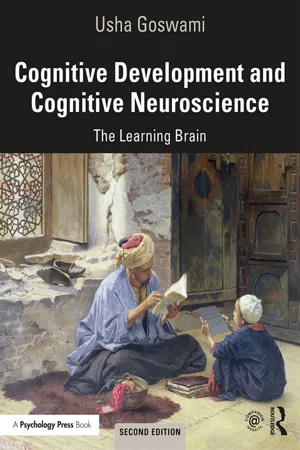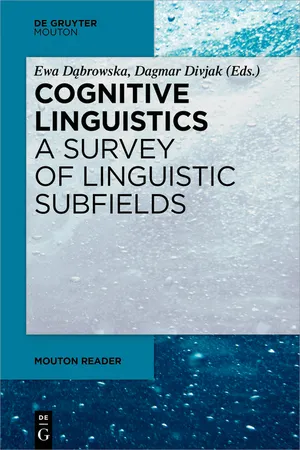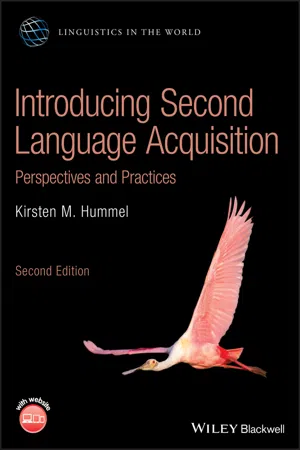Languages & Linguistics
Language Acquisition in Children
Language acquisition in children refers to the process through which they learn and develop language skills. This process involves the acquisition of vocabulary, grammar, and communication skills. Children typically acquire language through exposure to spoken and written language in their environment, and through interaction with caregivers and peers. The study of language acquisition in children is a key area of research in linguistics and developmental psychology.
Written by Perlego with AI-assistance
Related key terms
11 Key excerpts on "Language Acquisition in Children"
- eBook - ePub
- Bruce M. Rowe, Diane P. Levine(Authors)
- 2022(Publication Date)
- Routledge(Publisher)
Much of the recent research regarding first-language acquisition has focused on brain development. Many linguists believe that the potential for language is innate to humans, that children are born with their brains hardwired with the ability to learn language. This innateness hypothesis states that they are predisposed to a certain UG involving phonemic differences, word order, and phrase recognition. This hardwiring in the brain has been called a language acquisition device, and it seems to work only during childhood, according to the critical period hypothesis. It works despite poverty of the stimulus. Other proposals concerning language acquisition include the imitation hypothesis, the reinforcement hypothesis, the interactionist hypothesis (constructivism), and cognitive functionalism.Children seem to use their innate language abilities to extract the rules of the language. Within a few months of birth, babies begin cooing and then babbling. Around 1 year of age, children begin saying one-word utterances, which are referred to as holophrases; this stage of language acquisition is the holophrastic stage. Sometime after 18 months of age, children enter the two-word stage, in which they combine such words as agent–action, action–object, possessor–possession, and action–location. As children begin adding more words, their utterances are described as telegraphic speech. As they begin to learn the rules of morphology, they acquire the plural marker, which they overgeneralize.As early as 6 months of age, babies indicate that they understand the meaning of words by looking at the object or person mentioned. By the age of 6, their productive vocabulary will be about 14,000 words. Their receptive vocabulary is considerably larger. Children overextend the meanings of words; they may also underextend them. All adult words encompass a range of meanings; the child’s task in learning semantics is to learn the range of meanings that adults assign to each word. Language acquisition continues well into the school years.Children acquire more than one language as a result of either simultaneous bilingualism, where the child acquires two (or more) languages from birth, or sequential bilingualism, where the child acquires a second language after having begun to acquire a first language. There are two main hypotheses that propose how children acquire and process two or more languages: the unitary system hypothesis and the separate systems hypothesis. - eBook - ePub
The Cognitive Sciences
An Interdisciplinary Approach
- Carolyn P. Sobel, Paul Li(Authors)
- 2013(Publication Date)
- SAGE Publications, Inc(Publisher)
8The Role of Linguistics in Cognitive Science
Language AcquisitionFirst-Language AcquisitionStages in First-Language AcquisitionThe Social Aspect of First- Language AcquisitionSecond-Language AcquisitionLanguage DeprivationBilingualismLanguage Acquisition in Abused or Feral ChildrenLanguage Loss (Language Attrition)Language Acquisition in the Deaf and Hearing ImpairedCauses of Languages LossThe Role of Computational LinguisticsAphasiaLanguage and ThoughtComputational Modeling of LanguageL inguists search for the underlying commonalities among languages. Some reconstruct rules of languages no longer spoken, and some focus on the rules of languages currently spoken. The data they describe contribute to our knowledge of the types of rules and principles underlying languages. From these data we can infer much about the functioning of the cognitive processes that produce them. As you read in Part 1, cognitive psychology attempts to understand the processes our minds engage in, the cognitive architecture that makes it all possible. Thus, language is of great interest to those of us in the field of cognitive psychology, concerned as we are with issues of learning and of the representation of knowledge in the brain. The following is a look at some of the areas in cognitive psychology in which language plays a major role and where the overlap with linguistics is plain.LANGUAGE ACQUISITION
First-Language Acquisition
It is helpful to address at this point, because it is far from obvious, the way in which human infants acquire a language (or languages, for many learn more than one in the environment in which they are raised). The word infant - eBook - ePub
Learning to Read and Write
The Role of Language Acquisition and Aesthetic Development: A Resourcebook
- Ellen J. Brooks(Author)
- 2017(Publication Date)
- Routledge(Publisher)
Studied child’s judgments about language in relation to level of development of child’s own speech and comprehension. Found more correct judgments on semantic than syntactic items, thus suggesting the early importance of semantic features in making judgments. Study indicates a correlation between the child’s degree of linguistic complexity in natural speech and ability to make syntactic judgments.15. deVilliers, Peter A., and Jill G. deVilliers. Early Language . Cambridge, Mass.: Harvard University Press, 1979.A highly readable account of the process of language acquisition. The authors focus on how the child learns language, the sequence of language development, and determining what the child knows about language. Major topics include: the development of early speech sounds (phonology), learning words (semantics) and referential and expressive functions, acquisition of rules (syntax), relationships between language and experience, expansion of the context of language usage, awareness of language, the context of language acquisition (with emphasis on mother-to-child speech), and constraints on language learning. The authors acknowledge that parents model language behavior for their children, but this does not imply that language need be taught in a formal manner. Language acquisition is a natural process, and parents are encouraged to provide stimulation and a rich oral language environment. A very useful text for parents, caretakers, and professionals.16. Dore, John. “Conversational Acts and the Acquisition of Language.” In Developmental Pragmatics , edited by Elinor Ochs and Bambi B. Schieffelin. New York: Academic Press, 1979.Discusses the role of conversational acts (the basic units of communication) in language acquisition. Dore concludes that the child is “preprogrammed” with knowledge of abstract linguistic structure and that conversation provides the child with a context for language acquisition and a means to test his hypotheses about language.17. Downing, John, and Che Kan Leong. “Language Awareness.” In Psychology of Reading , by John Downing and Che Kan Leong. New York: Macmillan, 1982.In-depth coverage of linguistic awareness and how it relates to the process of learning to read. The authors begin with Chomsky’s discussion of linguistic competence as the theoretical perspective and go on to describe salient aspects of the rules of language. Excellent discussion; prior background needed as this is difficult reading. - eBook - ePub
The Sounds of Language
An Introduction to Phonetics and Phonology
- Elizabeth C. Zsiga(Author)
- 2012(Publication Date)
- Wiley-Blackwell(Publisher)
For both children and adults, we examine the tools used to study the phenomena, typical data for both speech perception and speech production, and the theories that are proposed to account for the data. Finally (Section 20.5), we end with a consideration of what the study of phonological acquisition and learning can teach us about linguistic theory. 20.1 Language Acquisition and Language Learning The goal of the linguist is to propose an explicit analysis; the goal of the learner is to gain the knowledge needed to become a proficient language user. When we speak of the process of gaining language proficiency as it applies to babies and children, we refer to language acquisition, and we call a native language acquired in childhood the L1. To say that language is “acquired” emphasizes the seeming effortlessness of the task. All babies, unless they have severe physical or cognitive disabilities, become competent (if not perfect) users of their native language by age 4. The process is not nearly so effortless for an adult learning a non-native language. (Linguists may call any non-native language an L2, even if it is the third or fourth in the speaker’s repertoire.) Most adults find the process of learning an L2 to be difficult, even with explicit instruction, and the results vary considerably. Differences in aptitude, motivation, type of instruction, and amount of social interaction play important roles in language learning for adults. Some adults have an aptitude for learning languages and are quite successful: some L2 speakers become so proficient that their speech is indistinguishable from that of a native. For most adult learners, however, a foreign accent of varying severity persists, even when the learner has been surrounded by native language users for many years - eBook - ePub
- Derek Bickerton(Author)
- 2014(Publication Date)
- Harvard University Press(Publisher)
CHAPTER 7Language “Acquisition”There is one thing (perhaps the only thing) on which virtually all writers on child language are agreed: that in the beginning there is a child, A, and a language, B, that A does not yet have, and that A aims (consciously or otherwise) at acquiring B by a specifically targeted effort of some kind. This effort may or may not be helped by unconscious knowledge internal to A, depending on one’s theoretical bias, but it is one that may best be characterized by the terms learning or acquisition and treated as a task rather than a set of automatic reactions.Granted Chomsky has often spoken of the “growth” of language, comparing it to the growth of physical organs such as arms and legs: “Language development really ought to be called language growth because the language organ grows like any other body organ” (Chomsky 1983), and accordingly “language learning is not something that the child does; it is something that happens to the child” (Chomsky 1988: 34). Yet over the years he has shown considerable ambivalence about the nature of acquisition. At the same time as he was making such statements, he was elaborating the notion of a Language Acquisition Device (LAD) that required assumptions no different from those of other models.The relationship of LAD to UG and the “knowledge of language” discussed in Chapter 2 rather resembles the relationship of the Trinity in Christian theology; they sometimes appear to be distinct from one another but are really aspects of a single entity. The LAD as a repository of “knowledge of language” supplies the child with a set of hypotheses about all possible languages that can be tested against primary linguistic data, enabling the child to identify the grammatical system of the local language (Chomsky 1965, 1972). In introducing the principles-and-parameters model of UG, Chomsky states that as regards “theory of language acquisition, we assume that the child approaches the task equipped with UG - eBook - ePub
Cognitive Development and Cognitive Neuroscience
The Learning Brain
- Usha Goswami(Author)
- 2019(Publication Date)
- Routledge(Publisher)
Chapter 6 Contents Phonological development Lexical development Grammatical development Pragmatic development Summary6
Language acquisition
KEY TERMS
Language acquisition device (LAD)
An innate neural mechanism, first suggested by Chomsky, with the special job of acquiring the language the infant encounters.Phonotactic patterns of language
Speech sounds that make up language, and the order in which these speech sounds can be combined to make lawful words.So far in this book, we have considered cognitive development largely independently of language. This is not accidental. Language acquisition has traditionally been studied separately from cognition, and as we have seen in previous chapters, there is strong commitment to the idea that basic concepts are pre-verbal. Another reason for the traditional distinction between language and thought was that language acquisition seemed such a remarkable feat for the infant brain that it was assumed that special capacities must be at work. These capacities were thought to be distinct from the capacities underpinning broader cognitive development. For example, it was postulated that infants were born equipped with a ‘language acquisition device’ or LAD, which had the special job of acquiring the spoken language of whichever culture the infant entered. Chomsky, the original proponent of the LAD, argued that infants are born with innate knowledge of the general rules that all languages obey, along with innate knowledge of permitted variations (e.g., Chomsky, 1957). Hence an infant can as readily acquire a language that makes heavy use of the passive tense (“The boy was bitten by the dog”), like Sesotho, as a language that does not, like English (“The dog bit the boy”; Bates, Devescovi & Wulfeck, 2001).More recently, it has become clear that language acquisition depends on the same kinds of learning mechanisms that underpin broader cognition. We have already seen in Chapters 1 to 5 that infants acquire a remarkable amount of information simply by looking at and listening to events that occur in their worlds. In the case of the physical, biological and psychological worlds, the primary sense is probably vision. In the case of language, the primary sense is audition. Infants acquire a remarkable amount of information simply by listening to what the people around them say. I will argue that infants use the same abilities to acquire language that they use to acquire knowledge about the physical, biological and psychological worlds, for example statistical and associative learning. The infant brain is automatically tracking statistical dependencies and conditional probabilities in language. Auditory perceptual information is replete with statistical patterns. There are acoustic cues to the phonotactic patterns of the language (the sounds that make up the language, and the orders in which they can be combined), to word boundaries and phrasing (largely carried by speech rhythm and duration cues), and to the emotional content of speech (largely carried by prosodic stress patterns and loudness cues). As in the visual world of objects and events, information that is initially gained passively via automatic neural encoding processes is rapidly supplemented by information gained through direct action by the infant, for example by imitation. In the case of language, infants start babbling and trying out sound combinations for themselves from very early on, and they also initiate verbal interactions by gooing and making comfort or distress sounds – in other words, they attempt to communicate - Ewa Dąbrowska, Dagmar Divjak(Authors)
- 2019(Publication Date)
- De Gruyter Mouton(Publisher)
Danielle Matthews and Grzegorz KrajewskiChapter 7: First language acquisition
1 Introduction
With every year of a child’s early life come remarkable bounds in language ability. In this chapter, we will cover some of the major linguistic abilities acquired by children under the age of five. Starting in infancy, we will consider how infants become able to direct others’ attention and start to break into conventional language by learning first words. We will then discuss how children refine their word knowledge, building an ever more adult-like lexicon. Next, we briefly describe the transition to combinatorial speech, which brings with it the possibility of grammar. On this topic, we first consider syntax and then inflectional morphology. Finally, we consider some pragmatic skills by focussing on the ability to refer to things effectively. Where appropriate, we will link findings in developmental psycholinguistics to Cognitive Linguistics as a theoretical framework. This framework has been popular with child language researchers for a number of quite different reasons. First, it recognises that natural languages reflect the ways humans perceive and conceptualise their environment. By virtue of viewing the world through roughly the same cognitive lens, so to speak, infants are in a good position to start acquiring the linguistic conventions of their community. Second, it is a usage-based framework, which sees developing linguistic systems as shaped by the utterances children have actually heard or produced themselves. Seen this way, language is not a given but has formed historically to meet the communicative needs of a speech community. Children need to learn conventions that have evolved over historical time. Third, it proposes that usage events are stored “redundantly”, even if they could, in principle, be decomposed and stored as separate words and rules. Learning and processing can take advantage of this redundancy. Fourth, it is non-reductionist (utterances are understood in terms of complex wholes, within which constituents are identified). Thus, the same processes that allow children to identify words in the speech stream could simultaneously help identify the structures into which the atomic elements of language can enter (Langacker 2000- eBook - ePub
Introducing Second Language Acquisition
Perspectives and Practices
- Kirsten M. Hummel(Author)
- 2013(Publication Date)
- Wiley-Blackwell(Publisher)
2 First Language AcquisitionAnyone concerned with the study of human nature and human capacities must somehow come to grips with the fact that all normal humans acquire language, whereas acquisition of even its barest rudiments is quite beyond the capacities of an otherwise intelligent ape.(Noam Chomsky, 1968, p. 59)Chapter outline2.0 Chapter overview2.1 From sound to word2.2 From word to sentence2.3 Theoretical views2.3.1 Behaviorist view2.3.2 Universal Grammar2.3.3 Interactionist approach2.3.4 Emergentism: Connectionist viewpoint2.4 First language vs second language acquisition2.4.1 L1 acquisition vs L2 acquisition contrasts2.4.2 L1 acquisition and L2 acquisition parallels2.5 Summing upKey concepts Self-assessment questions Discussion questions Exercises/Project ideas Further reading and viewing References2.0 chapter overview
The term “second language acquisition” suggests that a first language has already been acquired. Having a basic knowledge about first language acquisition, an ability that is an essentially universal aspect of the general human condition, can be considered as fundamentally important in order to better understand second language acquisition. This chapter will begin by providing a basic description of L1 development and by presenting theoretical views proposed to explain the processes underlying that development. The second part of this chapter will present some of the dimensions along which L2 acquisition differs from or parallels the L1 acquisition process.2.1 from sound to word
Cartoon 2.1 www.CartoonStock.com .Babies are born into the world unable to linguistically articulate specific desires, needs, feelings or intentions. However, as anyone who has had any experience with infants realizes, babies do manage to communicate in very vocal and physical ways, through various forms and intensities of crying, cooing, other sounds, and by using physical movements and gestures. In the space of a few short months, such responses come to be gradually replaced by more language-like sounds and by 12 months of age many children are already uttering their first words. - eBook - ePub
Introducing Second Language Acquisition
Perspectives and Practices
- Kirsten M. Hummel(Author)
- 2020(Publication Date)
- Wiley-Blackwell(Publisher)
The term “second language acquisition” suggests that a first language (L1) has already been acquired. Having a basic knowledge about L1 acquisition, an ability that is an essentially universal aspect of the general human condition, can be considered as fundamentally important in order to better understand second language (L2) acquisition. This chapter will begin by providing a basic description of L1 development and by presenting theoretical views proposed to explain the processes underlying that development. The second part of this chapter will present some of the dimensions along which L2 acquisition differs from or parallels the L1 acquisition process.2.2 from sound to word
Babies are born into the world unable to linguistically articulate specific desires, needs, feelings, or intentions. However, as anyone who has had any experience with infants realizes, babies do manage to communicate in very vocal and physical ways, through various forms and intensities of crying, cooing, other sounds, and by using physical movements and gestures. In the space of a few short months, such responses come to be gradually replaced by more language‐like sounds and by 12 months of age many children are already uttering their first words.Considerable research has gone into examining the L1 acquisition process and much of this information reveals that infants appear to come into the world equipped to acquire the language they are exposed to in their environment. Linguists often use the term “prewired” to describe this state of readiness. In fact, many linguists argue that innate structures are the only reasonable explanation for the rapidity of development and universality of stages that characterize L1 acquisition. Noam Chomsky, the pre‐eminent linguist of our times, uses the analogy of a child “learning” to walk: the child does not need to be taught to walk, he or she simply begins to put one foot ahead of the other, as soon as the child is able to stand erect (Searchinger 1995 ). Similarly, acquiring the language used in one's environment unfolds in the same way: children do not need to be deliberately “taught” to speak, they simply begin to do so.Substantial evidence supports the idea of a genetic predisposition for language. For instance, a number of studies have shown that infants show a preference for the human voice, and in particular for the mother's voice, as young as three days old (DeCasper and Fifer 1980 ). The preferences of very young infants can be measured using a technique known ashigh amplitude sucking(HAS) - eBook - ePub
- Arnd Witte(Author)
- 2014(Publication Date)
- De Gruyter Mouton(Publisher)
2 First language acquisition and early cognitive developmentWhen starting to learn a second language, most adult learners do so, intentionally or not, with reference to their previously internalized linguistic and cultural patterns for construal, as well as social norms and conventions of the L1 community. Since these have been acquired early in life in tandem with the process of developing mental functions, feelings, and plausibility structures, they have a deeply formative influence on all activities carried out by the subject, including learning another language and its use in sociocultural contexts. In this chapter, the acquisition of these influential L1 patterns and structures will be analyzed.Development, change, and transformation are central notions, not only for the complex constructs of culture and society, but also for the no less complex cognitive and emotional capacities of the individual; this is particularly evident in the constantly ongoing activities of learning. Throughout biological life, the mental functions of the individual never cease to develop (and this can include regressive development). The largest leap in individual development, be it physical or psychological, takes place in the first fifteen years of life, during infancy, childhood, and early adolescence. And within this time-span, the first months and years are a crucial period, during which children acquire the basic structures of knowledge through participatory, intersubjective engagement with others and Other. These basic structures are mediated by culturally-constructed symbolic sign systems, among which language is by far the most diverse and complex mediator. Language is a highly sensitive instrument for linking cognitive, semiotic, and social activities. Mediation is a hugely important process by which culturally constructed artifacts (first and foremost language), concepts, values, norms, beliefs, and frames are increasingly used to regulate intra- and intersubjective mental activities (i.e., thought and interaction). The structures and patterns of the first language, society, and culture have repercussions for the process of second language learning because of their normative influence on thought, emotion, and behavior; the L2 is approached from the linguistic, cultural, and psychological bases of the L1-mediated constructs. They are also relevant since the deeply ingrained tacit linguistic, conceptual, and cultural knowledge is usually taken to be universally valid by the person – an assumption which will be fundamentally unsettled by the experience of learning another language. Therefore, this chapter will analyze the acquisition of fundamental concepts and categories through the medium of the first language; a process that constitutes and transforms the subjective mind by immersion in linguistic, social, and cultural practices of the immediate environment of family, peers, playground, and school. - Peter Herriot(Author)
- 2013(Publication Date)
- Psychology Press(Publisher)
In view of the findings in the field of aphasia outlined above, it appears clear that the hypothesis of specific innate language mechanisms may not be in accord with the evidence. For a highly specific innate content might require a specific locus, and this is precisely what is absent even in adult language users. On the contrary, the facts lead one to hypothesise physiological functions involving interactions of many parts of the brain (see Pribram in Miller, Galanter and Pribram, 1960). On the other hand, it might be argued that it is not a specific locus which is required for an innate component, but rather a specific system, which could depend for its adequate functioning on many different parts of the brain. However, in this case, injury to any one part of the brain which subserves the physiological system should irretrievably disrupt language behaviour in childhood; and the extraordinary capacity for recovery in children is well-evidenced.7. Biological Bases of AcquisitionThe hypothesis of a general critical period for language learning has more support than the hypothesis of specific innate mechanisms. At the lower end of the age range for language acquisition, it would appear that a certain maturational level is a necessary condition. Lenneberg (1964, 1967) stresses the following indications of maturational readiness: regular preliminaries to the onset of speech, and regular stages of acquisition; difficulty in suppressing language despite blindness and deafness; and regular relations between the onset of speech and other achievements dependent on maturation (e.g. crawling, walking) in normal and retarded children. Lenneberg (1967) also draws many graphs illustrating the relations between certain indicators of brain development and the onset of language behaviour. However, it should be stressed that there is no specific evidence that a particular brain weight or specific biochemical or electrophysiological changes are necessary conditions for language.Different evidence is adduced for the end
Index pages curate the most relevant extracts from our library of academic textbooks. They’ve been created using an in-house natural language model (NLM), each adding context and meaning to key research topics.

